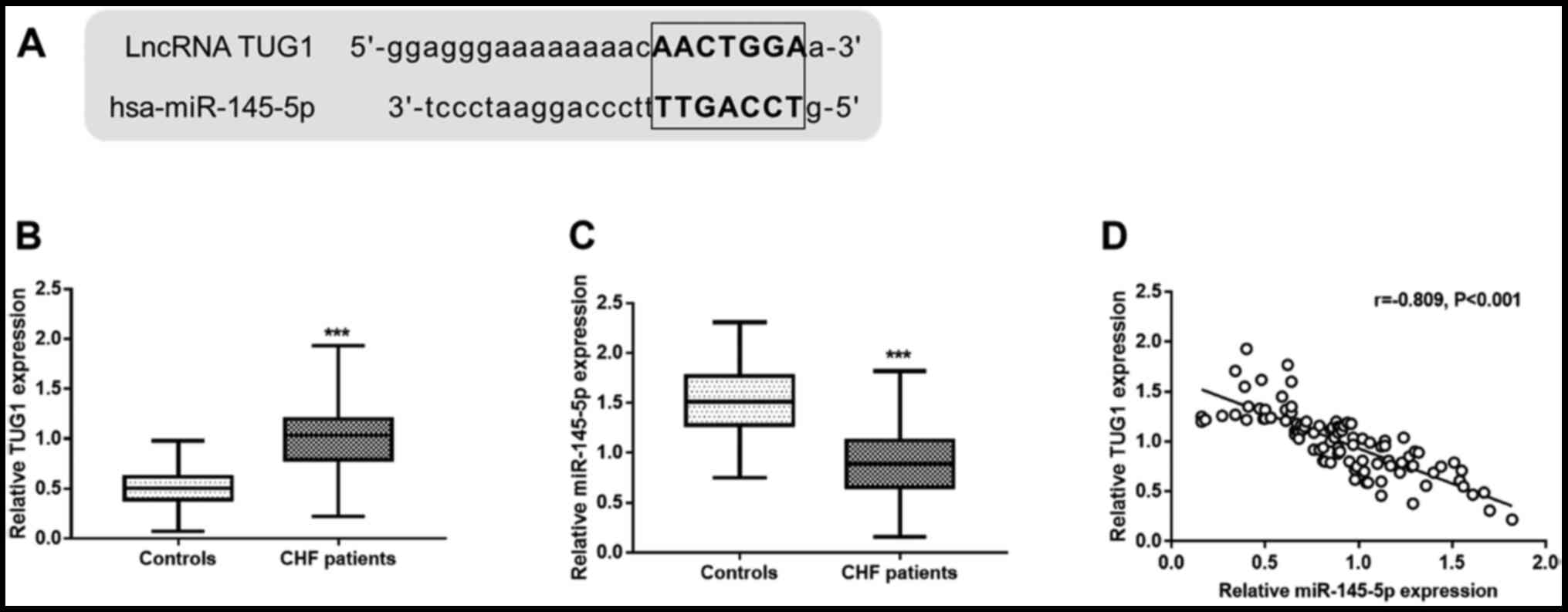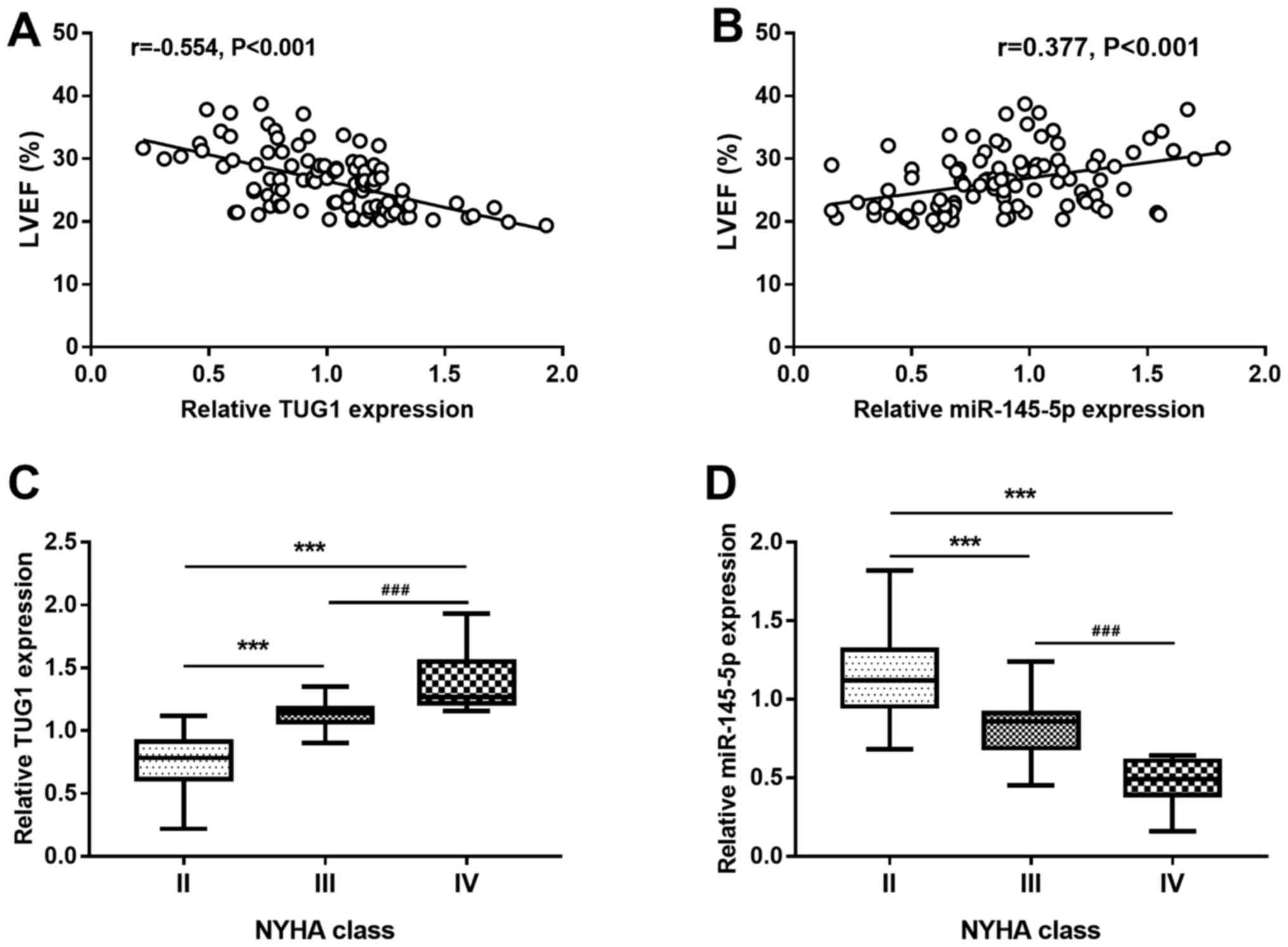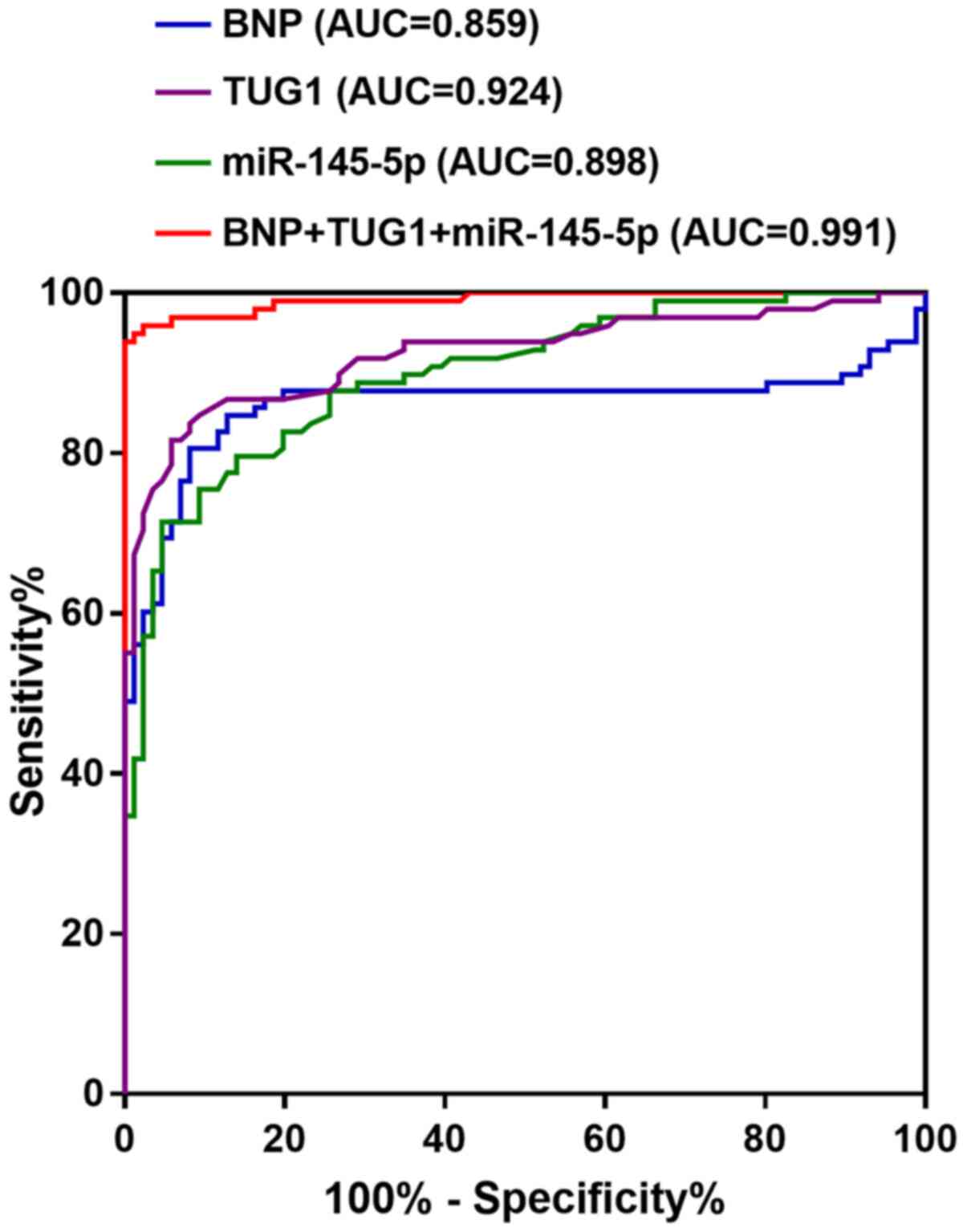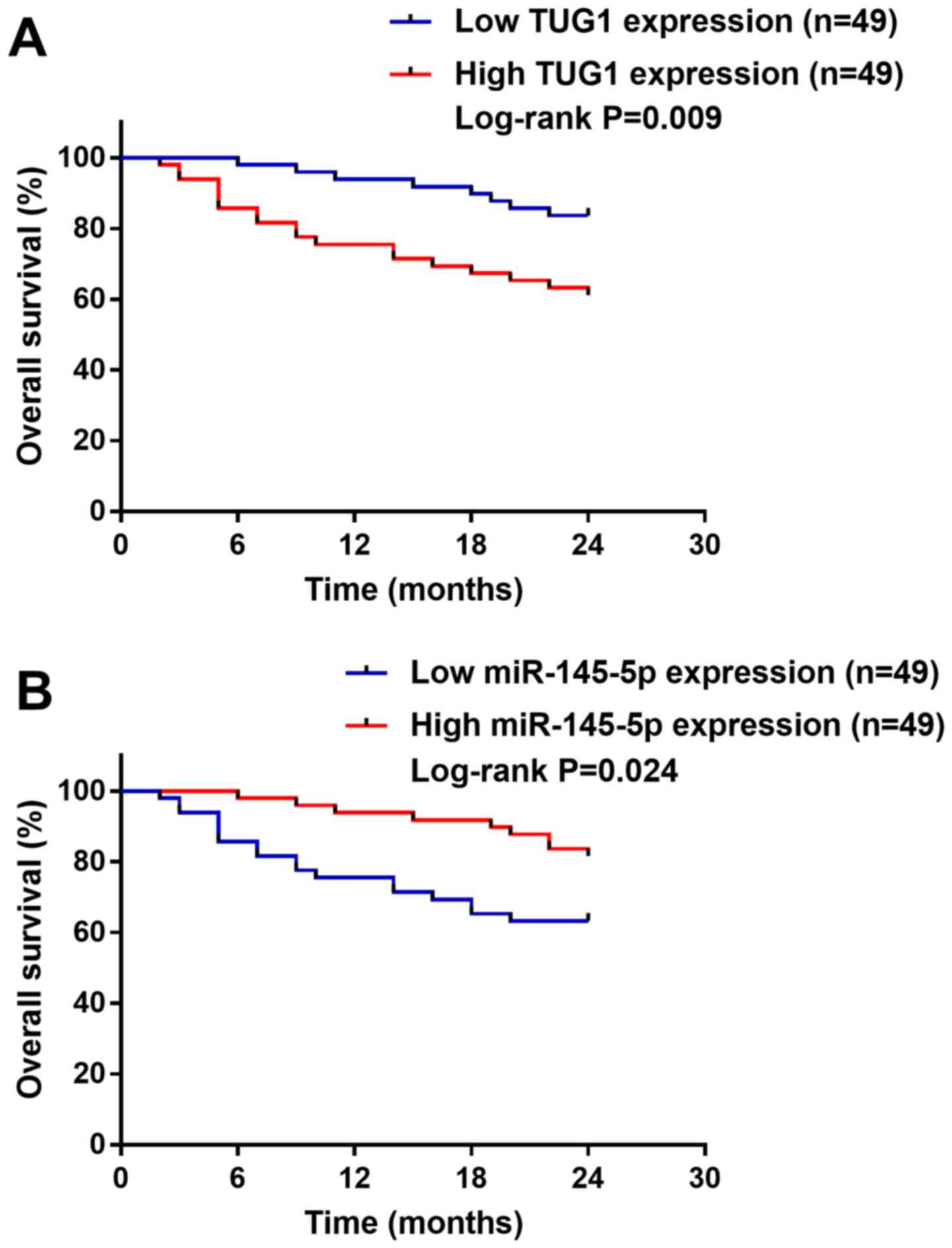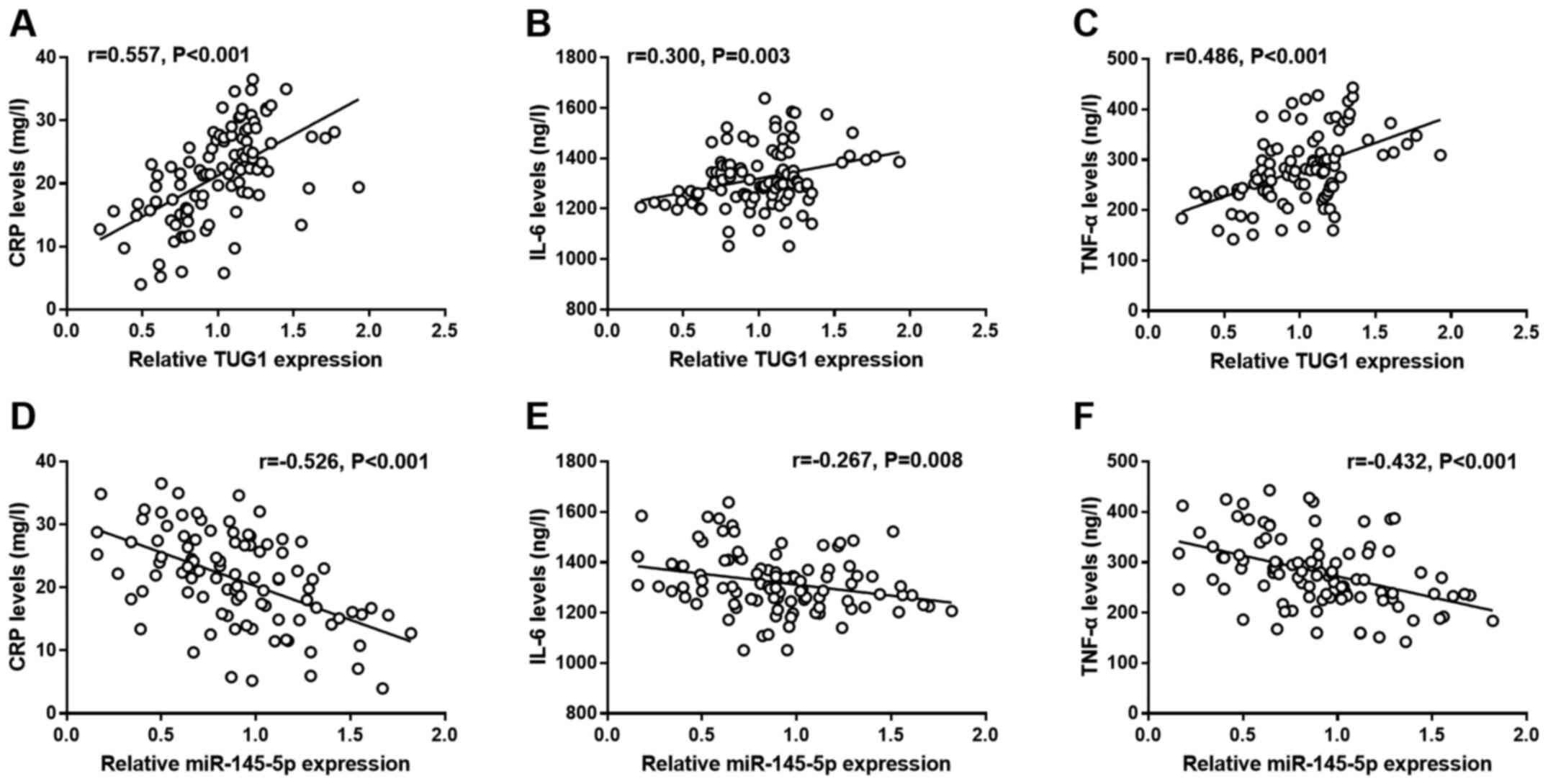|
1
|
Su Q, Zhang P, Yu D, Wu Z, Li D, Shen F,
Liao P and Yin G: Upregulation of miR-93 and inhibition of LIMK1
improve ventricular remodeling and alleviate cardiac dysfunction in
rats with chronic heart failure by inhibiting RhoA/ROCK signaling
pathway activation. Aging (Albany NY). 11:7570–7586.
2019.PubMed/NCBI View Article : Google Scholar
|
|
2
|
Kemp CD and Conte JV: The pathophysiology
of heart failure. Cardiovasc Pathol. 21:365–371. 2012.PubMed/NCBI View Article : Google Scholar
|
|
3
|
Sun B, Meng M, Wei J and Wang S: Long
noncoding RNA PVT1 contributes to vascular endothelial cell
proliferation via inhibition of miR-190a-5p in diagnostic biomarker
evaluation of chronic heart failure. Exp Ther Med. 19:3348–3354.
2020.PubMed/NCBI View Article : Google Scholar
|
|
4
|
Mosterd A and Hoes AW: Clinical
epidemiology of heart failure. Heart. 93:1137–1146. 2007.PubMed/NCBI View Article : Google Scholar
|
|
5
|
Pepys MB: The Pentraxins 1975-2018:
Serendipity, diagnostics and drugs. Front Immunol.
9(2382)2018.PubMed/NCBI View Article : Google Scholar
|
|
6
|
Sun S, Ou Y, Shi H, Luo J, Luo X, Shen Y,
Chen Y, Liu X, Zhu Z and Shen W: Myocardial damage associated with
elective percutaneous coronary intervention in Chinese patients: A
retrospective study. J Int Med Res.
48(300060520907783)2020.PubMed/NCBI View Article : Google Scholar
|
|
7
|
Carella DM: Brain Natriuretic Peptide:
It's not about the brain or just another smart polypeptide - It's
about the heart. Neonatal Netw. 34:355–359. 2015.PubMed/NCBI View Article : Google Scholar
|
|
8
|
Hiebert JB, Vacek J, Shah Z, Rahman F and
Pierce JD: Use of speckle tracking to assess heart failure with
preserved ejection fraction. J Cardiol. 74:397–402. 2019.PubMed/NCBI View Article : Google Scholar
|
|
9
|
Wei JW, Huang K, Yang C and Kang CS:
Non-coding RNAs as regulators in epigenetics (Review). Oncol Rep.
37:3–9. 2017.PubMed/NCBI View Article : Google Scholar
|
|
10
|
Chang G, Zhang W, Zhang M and Ding G:
Clinical value of circulating ZFAS1 and miR-590-3p in the diagnosis
and prognosis of chronic heart failure. Cardiovasc Toxicol: Jul 28,
2021 (Epub ahead of print). doi: 10.1007/s12012-021-09678-7.
|
|
11
|
Zhang H, Zhang N, Jiang W and Lun X:
Clinical significance of the long non-coding RNA NEAT1/miR-129-5p
axis in the diagnosis and prognosis for patients with chronic heart
failure. Exp Ther Med. 21(512)2021.PubMed/NCBI View Article : Google Scholar
|
|
12
|
Wu Z, Zhao S, Li C and Liu C: LncRNA TUG1
serves an important role in hypoxia-induced myocardial cell injury
by regulating the miR 145 5p Binp3 axis. Mol Med Rep. 17:2422–2430.
2018.PubMed/NCBI View Article : Google Scholar
|
|
13
|
Zou X, Wang J, Tang L and Wen Q: LncRNA
TUG1 contributes to cardiac hypertrophy via regulating miR-29b-3p.
In Vitro Cell Dev Biol Anim. 55:482–490. 2019.PubMed/NCBI View Article : Google Scholar
|
|
14
|
Huangfu FT, Tang LQ, Wang HQ, Zhao X and
Yang M: MiR-145-5p promotes myocardial cell apoptosis in rats with
myocardial infarction through PI3K/Akt signaling pathway. Eur Rev
Med Pharmacol Sci. 24:12904–12911. 2020.PubMed/NCBI View Article : Google Scholar
|
|
15
|
Yuan M, Zhang L, You F, Zhou J, Ma Y, Yang
F and Tao L: MiR-145-5p regulates hypoxia-induced inflammatory
response and apoptosis in cardiomyocytes by targeting CD40. Mol
Cell Biochem. 431:123–131. 2017.PubMed/NCBI View Article : Google Scholar
|
|
16
|
Li LL, Mao CD, Wang GP, Wang N and Xue AG:
MiR-145-5p alleviates hypoxia/reoxygenation- induced cardiac
microvascular endothelial cell injury in coronary heart disease by
inhibiting Smad4 expression. Eur Rev Med Pharmacol Sci.
24:5008–5017. 2020.PubMed/NCBI View Article : Google Scholar
|
|
17
|
Dong Y, Fan G, Li Y and Zhou Q: TUG1
represses apoptosis, autophagy, and inflammatory response by
regulating miR-27a-3p/SLIT2 in lipopolysaccharide-treated vascular
endothelial cells. J Surg Res. 256:345–354. 2020.PubMed/NCBI View Article : Google Scholar
|
|
18
|
Song B, Wu S, Ye L, Jing Z and Cao J:
LncRNA TUG1 knockdown mitigates inflammatory injury induced by
cigarette smoke extract in chronic obstructive pulmonary disease
via miR-34c/BRD4 axis. Biosci Rep: Aug 19, 2020 (Epub ahead of
print). doi: 10.1042/BSR20193896.
|
|
19
|
Zhao K, Tan JY, Mao QD, Ren KY, He BG,
Zhang CP and Wei LZ: Overexpression of long non-coding RNA TUG1
alleviates TNF-α-induced inflammatory injury in interstitial cells
of Cajal. Eur Rev Med Pharmacol Sci. 23:312–320. 2019.PubMed/NCBI View Article : Google Scholar
|
|
20
|
Yancy CW, Jessup M, Bozkurt B, Butler J,
Casey DE Jr, Drazner MH, Fonarow GC, Geraci SA, Horwich T, Januzzi
JL, et al: American College of Cardiology Foundation; American
Heart Association Task Force on Practice Guidelines: 2013 ACCF/AHA
guideline for the management of heart failure: A report of the
American College of Cardiology Foundation/American Heart
Association Task Force on Practice Guidelines. J Am Coll Cardiol.
62:e147–e239. 2013.PubMed/NCBI View Article : Google Scholar
|
|
21
|
Ponikowski P, Voors AA, Anker SD, Bueno H,
Cleland JG, Coats AJ, Falk V, González-Juanatey JR, Harjola VP,
Jankowska EA, et al: Authors/Task Force Members; Document
Reviewers: 2016 ESC Guidelines for the diagnosis and treatment of
acute and chronic heart failure: The Task Force for the diagnosis
and treatment of acute and chronic heart failure of the European
Society of Cardiology (ESC). Developed with the special
contribution of the Heart Failure Association (HFA) of the ESC. Eur
J Heart Fail. 18:891–975. 2016.PubMed/NCBI View
Article : Google Scholar
|
|
22
|
Livak KJ and Schmittgen TD: Analysis of
relative gene expression data using real-time quantitative PCR and
the 2(-Delta Delta C(T)) method. Methods. 25:402–408.
2001.PubMed/NCBI View Article : Google Scholar
|
|
23
|
Li JH, Liu S, Zhou H, Qu LH and Yang JH:
starBase v2.0: Decoding miRNA-ceRNA, miRNA-ncRNA and protein-RNA
interaction networks from large-scale CLIP-Seq data. Nucleic Acids
Res. 42:D92–D97. 2014.PubMed/NCBI View Article : Google Scholar
|
|
24
|
Deng H, Ouyang W, Zhang L, Xiao X, Huang Z
and Zhu W: LncRNA GASL1 is downregulated in chronic heart failure
and regulates cardiomyocyte apoptosis. Cell Mol Biol Lett.
24(41)2019.PubMed/NCBI View Article : Google Scholar
|
|
25
|
Xiao N, Zhang J, Chen C, Wan Y, Wang N and
Yang J: miR-129-5p improves cardiac function in rats with chronic
heart failure through targeting HMGB1. Mamm Genome. 30:276–288.
2019.PubMed/NCBI View Article : Google Scholar
|
|
26
|
Li G, Du P, Qiang X, Jin D, Liu H, Li B
and Guo J: Low-expressed GAS5 injure myocardial cells and
progression of chronic heart failure via regulation of miR-223-3P.
Exp Mol Pathol. 117(104529)2020.PubMed/NCBI View Article : Google Scholar
|
|
27
|
Su Q, Liu Y, Lv XW, Dai RX, Yang XH and
Kong BH: LncRNA TUG1 mediates ischemic myocardial injury by
targeting miR-132-3p/HDAC3 axis. Am J Physiol Heart Circ Physiol.
318:H332–H344. 2020.PubMed/NCBI View Article : Google Scholar
|
|
28
|
Yang D, Yu J, Liu HB, Yan XQ, Hu J, Yu Y,
Guo J, Yuan Y and Du ZM: The long non-coding RNA TUG1-miR-9a-5p
axis contributes to ischemic injuries by promoting cardiomyocyte
apoptosis via targeting KLF5. Cell Death Dis.
10(908)2019.PubMed/NCBI View Article : Google Scholar
|
|
29
|
Wu G, Tan J, Li J, Sun X, Du L and Tao S:
miRNA-145-5p induces apoptosis after ischemia-reperfusion by
targeting dual specificity phosphatase 6. J Cell Physiol.
234:16281–16289. 2019.PubMed/NCBI View Article : Google Scholar
|
|
30
|
Maggioni AP: Epidemiology of heart failure
in Europe. Heart Fail Clin. 11:625–635. 2015.PubMed/NCBI View Article : Google Scholar
|
|
31
|
Farnsworth CW, Bailey AL, Jaffe AS and
Scott MG: Diagnostic concordance between NT-proBNP and BNP for
suspected heart failure. Clin Biochem. 59:50–55. 2018.PubMed/NCBI View Article : Google Scholar
|
|
32
|
Collin-Chavagnac D, Manchon M, Traulle C
and Bernon H: False-positive BNP results in a 78-year-old man
caused by monoclonal IgM-kappa: A case report. Clin Chim Acta.
384(179)2007.PubMed/NCBI View Article : Google Scholar
|
|
33
|
Chao Y and Zhou D: lncRNA-D16366 is a
potential biomarker for diagnosis and prognosis of hepatocellular
carcinoma. Med Sci Monit. 25:6581–6586. 2019.PubMed/NCBI View Article : Google Scholar
|
|
34
|
Naizhaer G, Kuerban A, Meilipa Kuerban R
and Zhou P: Up-regulation of lncRNA FALEC indicates prognosis and
diagnosis values in cervical cancer. Pathol Res Pract.
215(152495)2019.PubMed/NCBI View Article : Google Scholar
|
|
35
|
Han S, Li P, Wang D and Yan H:
Dysregulation of serum miR-1204 and its potential as a biomarker
for the diagnosis and prognosis of breast cancer. Rev Assoc Med
Bras. 66:732–736. 2020.PubMed/NCBI View Article : Google Scholar
|
|
36
|
Shi W, Lu Y, Gong R, Sun JJ and Liu G:
Serum miR-629 is a novel molecular marker for diagnosis and the
prognosis of pancreatic cancer. Eur Rev Med Pharmacol Sci.
22:5187–5193. 2018.PubMed/NCBI View Article : Google Scholar
|
|
37
|
Zhang L, Wu YJ and Zhang SL: Circulating
lncRNA MHRT predicts survival of patients with chronic heart
failure. J Geriatr Cardiol. 16:818–821. 2019.PubMed/NCBI View Article : Google Scholar
|
|
38
|
van Boven N, Akkerhuis KM, Anroedh SS,
Rizopoulos D, Pinto Y, Battes LC, Hillege HL, Caliskan KC, Germans
T, Manintveld OC, et al: Serially measured circulating miR-22-3p is
a biomarker for adverse clinical outcome in patients with chronic
heart failure: The Bio-SHiFT study. Int J Cardiol. 235:124–132.
2017.PubMed/NCBI View Article : Google Scholar
|
|
39
|
Yan JJ, Qiao M, Li RH, Zhao XT, Wang XY
and Sun Q: Downregulation of miR-145-5p contributes to
hyperproliferation of keratinocytes and skin inflammation in
psoriasis. Br J Dermatol. 180:365–372. 2019.PubMed/NCBI View Article : Google Scholar
|
|
40
|
Zhang H, Li H, Ge A, Guo E, Liu S and
Zhang L: Long non-coding RNA TUG1 inhibits apoptosis and
inflammatory response in LPS-treated H9c2 cells by down-regulation
of miR-29b. Biomed Pharmacother. 101:663–669. 2018.PubMed/NCBI View Article : Google Scholar
|















